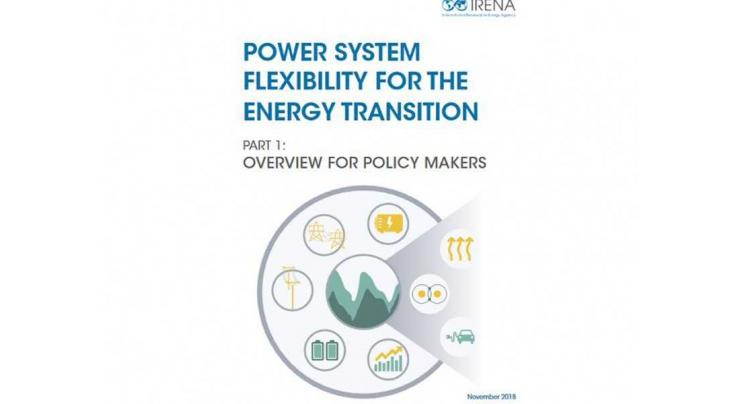
- Home
- Middle East
- UAE
- <span>Making power systems more flexible as global energy transition accelerates: IRENA's repor ..
Making Power Systems More Flexible As Global Energy Transition Accelerates: IRENA's Report
Umer Jamshaid Published November 13, 2018 | 08:45 PM

ABU DHABI, (UrduPoint / Pakistan Point News / WAM - 13th Nov, 2018) The global energy landscape is witnessing a rapid and disruptive change driven by an unprecedented growth in renewables, according to a new report released by Abu Dhabi-based International Renewable Energy Agency (IRENA). Last year alone, a record-breaking 168 GW of renewable energy capacity were added globally – the sixth consecutive year in which additions from renewables have exceeded those from conventional sources. Today, a quarter of the world’s electricity comes from renewables.
But, the recent IPCC report has sent a clear signal and called for a scaling up of renewables both in the power and in end use sectors such as transport and buildings. This echoes IRENA’s own analysis which estimates that avoiding the worst effects of global warming will require to source 85% of global power and two-thirds of total energy supply from renewables by 2050. Around 60% of electricity would come from so called variable renewable energy (VRE) like solar and wind.
Experiences from frontrunner countries show that flexibility in the power system can help integrating solar and wind into the market.
With today’s report on Power system flexibility for the energy transition and a new tool to assess the flexibility of the power system – the FlexTool – IRENA opens a new work stream that support its members in finding the most cost-effective mix of flexibility solutions. The tool has been applied jointly with IRENA members Colombia, Panama, Uruguay and Thailand to assess the flexibility of their power system based on the latest national plans.
Claudia Cabrera from the Ministry of Industry, Energy and Mining (MIEM) of Uruguay, who presented the Uruguayan FlexTool analysis during the 16th meeting of the IRENA Council, said: "The FlexTool can assess in an integrated manner sector coupling alternatives, which is an aspect of great importance in an electric system like the Uruguayan characterized by energy surpluses.
Therefore, the IRENA FlexTool can complement the existing planning toolkit by providing additional insights on flexibility and options to further increase it." The Uruguayan FlexTool analysis concluded that Uruguay's power system is flexible enough to accommodate the actual and future deployment of VRE resulting from the country’s long-term generation expansion plan.
Dolf Gielen, Director of IRENA’s Innovation and Technology Center, added: "The new report showcases flexibility in all parts of the energy system. Findings show that the smooth integration of variable renewable energy into power systems requires innovations. Beyond technological solutions, flexibility can be unlocked through market design, operational practices and new business models."
Demand has a significant potential to contribute to the flexibility of the power system - from quickly responding to supply shortages to following price signals in order to consume energy when it is cheaper, and the grid does not face congestion. A central element of flexibility is sector-coupling, the coupling of energy demand for heat, fuels and mobility by using power to heat (e.g. heat pumps), power to gas (e.g. hydrogen from renewable electricity) and power to mobility. Electric vehicles for example can act as battery storage devices if regulations and technologies are aligned and provide short term storage and grid services.
Related Topics
Recent Stories

Venezuela shuts Ecuador diplomatic missions over raid

France and Germany will slow eurozone down: IMF

UN to launch $2.8 bn global appeal for Gaza, West Bank

COAS, Saudi FM discuss bilateral cooperation in various sectors

Big industry grows by 0.06 % in February 2024

PTI's plan to destroy national economy has failed: Senator Talal Chaudhry

Fire at Copenhagen landmark 'under control'

Hub rally on April 28

Saudi delegation's visit to usher in new era of close cooperation: Prime Ministe ..

Erdogan says Netanyahu to blame for Iran's attack on Israel

Human traffickers gang busted in Mirpurkhas, 2 girls rescued

Man killed in Attock
More Stories From Middle East
-

UAE announces ‘Zero Bureaucracy Program’ to reduce bureaucracy
2 months ago -

COP28 President-Designate welcomes Transitional Committee agreement to operationalise Loss and Damag ..
5 months ago -

Global Media Congress 2023 to feature Co-Production Majlis as a new networking platform
5 months ago -

Young female athletes shine at Abu Dhabi World Youth Jiu-Jitsu Championship
5 months ago -

King of Jordan receives Abdullah bin Zayed and ministers participating in Arab coordination meeting
5 months ago -

Abdullah bin Zayed participates in coordination meeting of Arab foreign ministers, joint meeting wit ..
5 months ago
-

3rd annual conference of Emirates Society of Clinical Microbiology kicks off in Dubai
5 months ago -

SIBF 2023 hosts Nobel laureate to discuss emergence of ‘Afrofuturism’ in global discourse
5 months ago -

ALC announces winners of Kanz Al Jeel Award 2023
5 months ago -

SIBF turns spotlight on remarkable contributions of women
5 months ago -

Global assets in spot bitcoin ETFs hit $4.16 billion
5 months ago -

Rescuers struggle to find Nepal quake survivors as deaths reach 157
5 months ago











